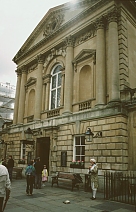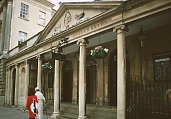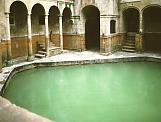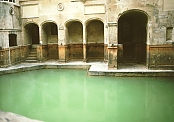

Although the Roman Empire disintegrated in the 5th century C. E., the Bath waters maintained their reputation for healing throughout the Middle Ages. Even though the waters were often described as stinking or dirty, the Baths were still in use during the Renaissance. But by the middle of the 18th century, Bath enjoyed a rebirth as a fashionable resort, with Richard "Beau" Nash as arbiter of Bath society. In the morning visitors met in the Pump Room to drink the requisite three glasses of water and to socialize to the sound of music; later, below the Pump Room, they waded in the King's Bath (see below). Eighteenth and nineteenth century plays (Sheridan's The Rivals), novels (by Fielding and Smollett), and essays record the importance of this resort. The city was also being rebuilt during this time, with an Assembly Room (1777)--the center of social life--by John Wood the Younger, and elegant apartment buildings. (See The Circus by John Wood I, begun 1754, and the Royal Crescent by John Wood II, begun 1767-75.)The entrance to the Pump Room (left and center); entrance to the King's and Queen's Baths (right) | ||
 |
 |
 |
 |
 |
The King's Bath(not part of the original Roman structure) |
 Click here to return to index of art historical sites.
Click here to return to index of art historical sites.
 Click here to return to index of artists and architects.
Click here to return to index of artists and architects.
 Click here to return to chronological index.
Click here to return to chronological index.
